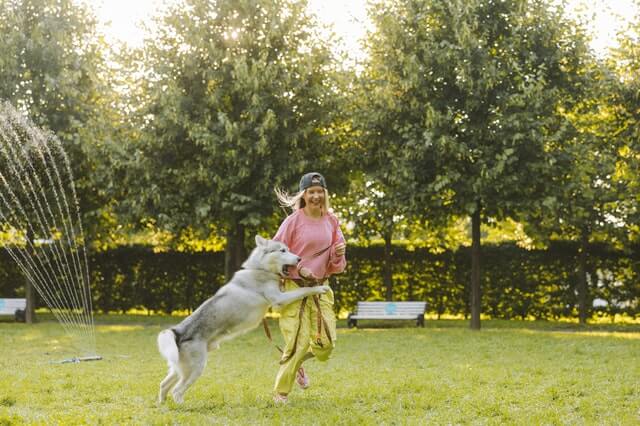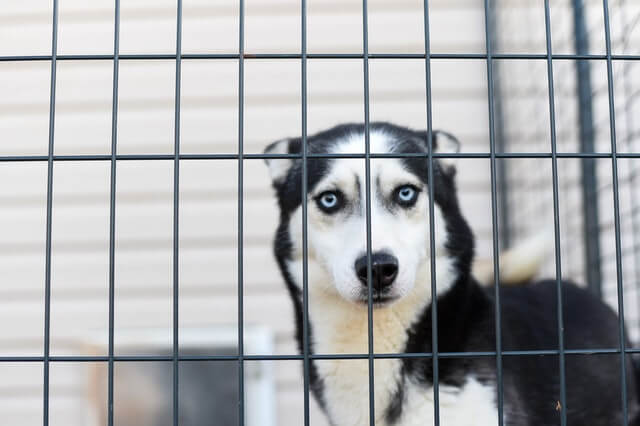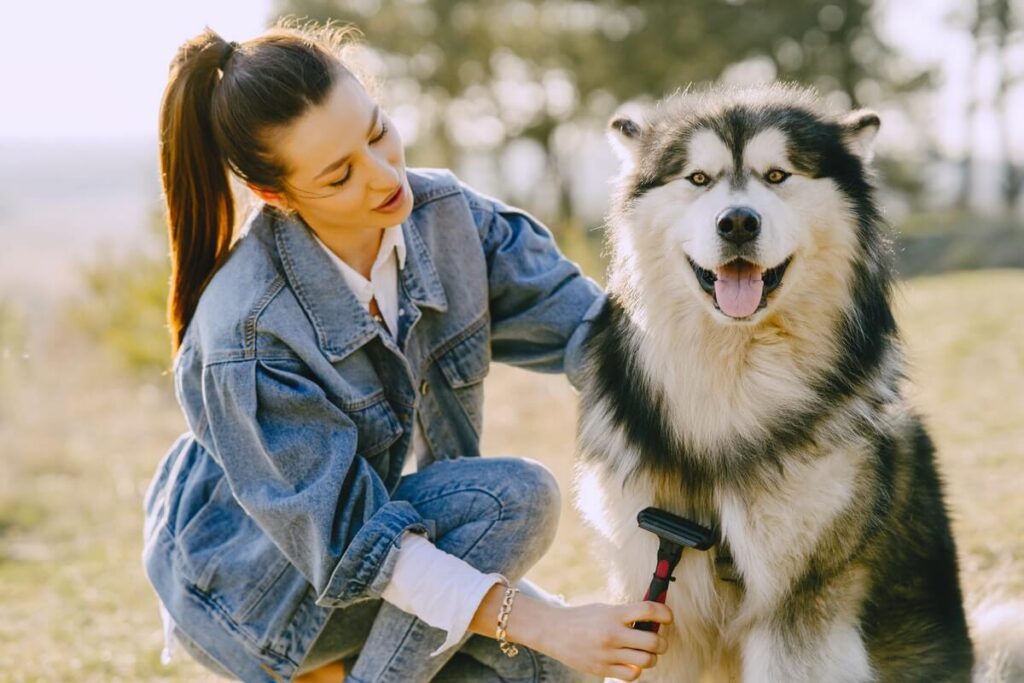Everyone falls for the wolf-like allure wrapped up in a friendly dog named Siberian Husky. Your love for this breed may not have any boundaries but we cannot deny the fact that this is a challenging breed to own. Along with stubbornness, behavioral issues, and moody nature, Huskies live to escape and run due to their high energy levels. It can become very problematic and frustrating at times even for dedicated pet parents. For the same reason, it is very important to start Siberian Husky training in the early periods of his life.
Once they are properly trained, they make wonderful pets. Knowing how to train a Siberian Husky can prove beneficial for house training. Here is a helping paw as this article mentions almost all the basic tips and tricks to train a husky in the easiest way possible.
Decide The Ways to Train!

If not the most important but one of the most crucial parts of training is the way you train your dog. Huskies have a slightly different temperament than many other dog breeds. It requires a unique approach to train them properly. Many different styles and approaches to training a dog are available, but the most fruitful is positive reinforcement-based training. It gets you the best results no matter how old your puppy or dog is!
Positive Reinforcement-Based Training
With this mode of training, you only praise and reward your Husky for his good and correct behaviors and actions. If your dog fails to follow you or makes a mistake, it is okay to show him what is wrong but you never reprimand or punish him. You focus only on the action he gets right and makes him realize it by praising him or giving treats.
This approach works the best because Huskies tend to appease their owners and are attention seekers. If you praise your dog during training sessions, he would build a positive association between the actions he did correctly. He will focus on the good behaviors that earn him a good response. They would love to replicate that behavior for your approval and positive attention.
Avoid Reprimand or Violence
Husky is an intelligent and sensitive dog breed. They fully receive and process actions, turns, and energy. They learn slowly with time what actions will earn them a reward. The main point is that you should never get frustrated with him. Huskies are stubborn and unbelievably do exactly the opposite of what we want. They love being defiant and challenging to their owners.
But you should never inflict physical or emotional violence upon them while training. It only makes things more difficult for both of you. Once your husky associates an action or behavior with abuse or reprimand, he would lose the willingness to obey the commands.
Be The Alpha of Your Pack
Huskies are natural hunters. Training from a young age is essential for them as they can develop destructive behaviors. Asserting dominance over your husky from a young age is instrumental in ensuring proper behavior. Therefore, you must start the Husky training by being a good leader. Although this strategy is outdated in the case of many other breeds, it works pretty well for Huskies.
It is because Huskies have a strict hierarchy order and tend to change their leader who does not enforce his rules upon them. If you fail to establish yourself as a good leader while your husky is still young, he will end up ignoring your command rather than responding to it.
Socialization

You must take the husky from a breeder who takes a puppy’s socialization seriously. Socialization means that your dog is already exposed to other animals, places, people, children, sounds, and smells. Without proper socialization, Huskies cannot develop a positive relationship with you or certain people or places once you take him home.
Even after you bring him home, continue the socialization training. Introduce him to strangers, children, and other animals or places. Always treat and praise him when he is calm in such situations and shows good behavior. If they feel aggressive or anxious, divert their attention and change your direction. Always discourage such behavior by “no” or “stop” commands.
Introduce to Children and Other Animals

Although Huskies get along well with the kids, they sometimes consider them as their pack members so they can play roughly with them. They just need to develop social boundaries with the children. You should train your Husky not to jump, grab, chase, bolt, or pull a child. Children also need to follow similar boundaries. Teasing, roughing, chasing, pulling hair, tail, or ears; or tug-of-war should not be allowed. Gentle touch and petting help build a trusting friendship and affection for each other.
Huskies are natural hunters so they tend to chase small animals. They might consider cats or small birds as their food. It is better to avoid having another pet at all. If your husky is already socialized to other animals, you can train him to be good around the small animals in your home too.
Use 3 Cs (Clear, Consistent, Cues)
Have a clear set of instructions and commands for your husky. A “drop” command should not be used in place of “down” if you have not trained your dog for it. Using multiple words for the same command only confuses the dog. Once you have defined a certain word for a particular command, always use the same word.
Be consistent in your training schedules. Do not take breaks from the husky training periods. Daybreak causes a huge inconsistency in training your dog. Moreover, set some rules and stick to them no matter what. If your husky is not allowed to lay in your bed or eat on the table, you should be consistent in discouraging him from doing so.
Give verbal cues and tone of your voice to mark the good and bad behavior of your dog. When he shows good behavior, mark his action with a smile and say “Good Boy!”. Similarly, when he fails to follow your command or does something wrong, mark the expression by frowning, a hand gesture, a sharp gaze, or saying “uh!” or “no!” etc.
Crate Training

A crate is only needed at the beginning of the husky training process when your pup is teething or before he is potty trained. Once he gets initial training sessions, the need for the crate becomes less. You may only need it on a few occasions like during car travel. Nevertheless, the crate is an excellent way to keep your Husky safe and manageable while he is still young.
- Start with making the crate a comfortable place.
- Desensitize your husky to the crate by letting him walk into it by himself.
- At the start, do not close the door.
- While he is inside, throw the treat into the crate.
- Let him run back out. Repeat it a few times.
- Play with the door of the crate.
- Use the “Sit!” command.
- Throw the treat inside it and say the word “crate.”
- After he gets inside and is comfortable with the crate, close the door.
- Treat and praise him.
- Say “Free!” while releasing him.
Prevent Chewing
Chewing is a common habit of Huskies like many other dog breeds. They chew to explore new things and relieve stress. It is also important for their oral Hygiene. As soon as the desire strikes, your dog needs something to chew. It can result in disaster as a dog cannot differentiate between the things he is allowed to chew or not.
So you must provide him with chewing toys, essentially in most places of your house and car. Associate using the chewing toys with positive reinforcement and discourage chewing of any other item.
Prevent Digging
Siberian huskies have an instinct to dig despite extensive training. They cannot resist it. To avoid letting him turn your beautiful garden landscape into a moonscape, you must train him to dig only a particular area. Specify a place where he can dig, like a sandpit. Supervise and discourage him where digging is not appropriate. You can bury dog excrement in those places where you want to prevent digging.
In the case of Siberian Huskies, digging along the fence line is a major issue of concern. You must regularly watch for the signs of digging along the fences. Partially bury the dog faces there to discourage your husky from digging there.
Prevent Mounting or Biting
Mouthing is a serious problem and can escalate to biting if not stopped at the early age of a husky pup. It can be a defense strategy or just a playful behavior for the dog. You need to discourage your pup whenever he starts mouthing or biting. If he is biting an object simply use the command “No!” and take the object from him.
If he bites you, let him realize that it hurts whether you are injured or not. Once he realizes that his biting can cause harm to others, he would refrain from it the next time. Say “ouch!” when he bites. If it does not help, use the command “No!” and stop playing with him. Move away from him and ignore his actions. Repeat this whenever he bites until he stops doing so.
Potty Training
Training a Siberian husky to housebreak is no science. You can use simple tricks to make him poop outside or at a specific spot. You should start potty training your pup from day one. First of all, find an appropriate place for him to urinate or defecate either inside or outside your house. Bring your husky to the same spot frequently after meals, exercise, or play sessions.
Once they are done with their business there, reward them with treats and praises. Stick to your routine and follow it regularly. As you cannot take your husky outside at night, remove his leftover food or water to keep him from messing up inside the house.
Leash Training

Siberian huskies were bred as sled dogs so they are naturally active dog breeds. They have a high metabolism and high energy levels that require regular walks and exercise. As such, you have to train your dog to walk on a leash. It prevents accidents when you are out with your fellow. First, practice the leash training at home, and then take your Husky outside.
- Let your dog explore the leash.
- Put it on once he gets comfortable with it.
- Let him get used to it.
- After that, grab the leash in your hands and hold it loosely.
- Use treats and praises to keep your Husky calm and close to you.
- Introduce the command, “Heel!” whenever you introduce him to harness.
- Once you are done with practice at home, start practicing outside.
Teaching Basic commands
The basic commands that your Siberian husky should learn during the obedience training are; sit, heel, no, yes, put it down, leave it, come, go, and many more. These commands prove way beneficial in other training practices as well. You must train your husky to learn these basic commands at an early age. Many of these commands follow the same set of rules and tricks.
- Hold a treat in your hand.
- When he is about to take it, say “command” and close your fist.
- Keep the fist closed until he obeys.
- Reward him with your other hand.
- Keep your other fist closed while doing so.
- Use firm eye contact and appropriate gestures to command.
Name Recognition
No dog can understand or comprehend that he has a name. A name to a dog is merely an obedience command that makes him attentive towards you. The command means “Look up to me and pay attention”. Name recognition is important to develop communication and relationship with your dog.
- Make your dog pay heed to the treats in your hands.
- Slowly bring that treat up to your husky’s forehead and hold it there.
- Make strong eye contact with him as he looks up.
- Say his name and give the treat.
- Call his name again.
- If they look up to you upon calling, say their name, then “yes!” and treat him.
Final Thoughts
The strong and demanding nature of Huskies can make the training process slightly difficult. Do not be afraid to call a professional for help before your furry ball’s bad habits become entrenched. Siberian Huskies are not first-time owners. A Husky trainer must be able to understand his dog’s unique needs and personalities. With proper training, the rewards can be fruitful!





